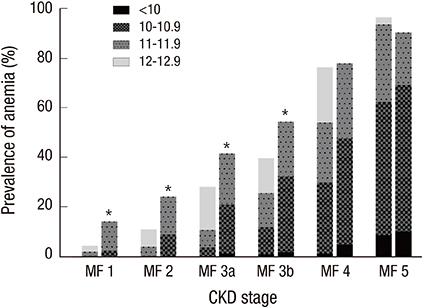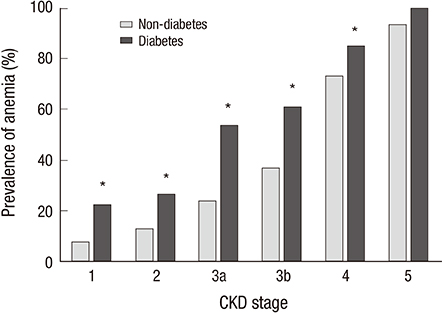J Korean Med Sci.
2017 Feb;32(2):249-256. 10.3346/jkms.2017.32.2.249.
The Prevalence and Management of Anemia in Chronic Kidney Disease Patients: Result from the KoreaN Cohort Study for Outcomes in Patients With Chronic Kidney Disease (KNOW-CKD)
- Affiliations
-
- 1Department of Internal Medicine, Yeosu Chonnam Hospital, Yeosu, Korea.
- 2Department of Preventive Medicine, Seoul National University College of Medicine, Seoul, Korea.
- 3Department of Internal Medicine, Gachon University, Gil Hospital, Incheon, Korea.
- 4Department of Internal Medicine, Inje University Busan Paik Hospital, Busan, Korea.
- 5Department of Internal Medicine, Seoul National University Boramae Medical Center, Seoul, Korea.
- 6Department of Internal Medicine, Severance Hospital, Yonsei University, Seoul, Korea.
- 7Department of Internal Medicine, Eulji Medical Center, Eulji University, Seoul, Korea. soi@eulji.ac.kr
- KMID: 2364168
- DOI: http://doi.org/10.3346/jkms.2017.32.2.249
Abstract
- Anemia is a common and significant complication of chronic kidney disease (CKD). However, its prevalence and current management status has not been studied thoroughly in Korea. We examined the prevalence of anemia, its association with clinical and laboratory factors, and utilization of iron agents and erythropoiesis stimulating agents using the baseline data from the large-scale CKD cohort in Korea. We defined anemia when hemoglobin level was lower than 13.0 g/dL in males and 12.0 g/dL in females, or received by erythropoiesis stimulating agents. Overall prevalence of anemia was 45.0% among 2,198 non-dialysis CKD patients from stage 1 to 5. Diabetic nephropathy (DN) as a cause, CKD stages, body mass index (BMI), smoking, leukocyte count, serum albumin, iron markers, calcium, and phosphorus concentration were identified as independent risk factors for anemia. Considering the current coverage of Korean National Health Insurance System, only 7.9% among applicable patients were managed by intravenous iron agents, and 42.7% were managed by erythropoiesis stimulating agents.
Keyword
MeSH Terms
Figure
Cited by 1 articles
-
Hepcidin as a Biomarker of Cardiorenal Syndrome
Gheun-Ho Kim
J Korean Med Sci. 2020;35(1):. doi: 10.3346/jkms.2020.35.e20.
Reference
-
1. Smith RE Jr. The clinical and economic burden of anemia. Am J Manag Care. 2010; 16:Suppl Issues. S59–S66.2. van Nooten FE, Green J, Brown R, Finkelstein FO, Wish J. Burden of illness for patients with non-dialysis chronic kidney disease and anemia in the United States: review of the literature. J Med Econ. 2010; 13:241–256.3. Farag YM, Keithi-Reddy SR, Mittal BV, Surana SP, Addabbo F, Goligorsky MS, Singh AK. Anemia, inflammation and health-related quality of life in chronic kidney disease patients. Clin Nephrol. 2011; 75:524–533.4. Iseki K, Kohagura K. Anemia as a risk factor for chronic kidney disease. Kidney Int Suppl. 2007; S4–S9.5. Kurella Tamura M, Vittinghoff E, Yang J, Go AS, Seliger SL, Kusek JW, Lash J, Cohen DL, Simon J, Batuman V, et al. Anemia and risk for cognitive decline in chronic kidney disease. BMC Nephrol. 2016; 17:13.6. Babitt JL, Lin HY. Mechanisms of anemia in CKD. J Am Soc Nephrol. 2012; 23:1631–1634.7. Astor BC, Muntner P, Levin A, Eustace JA, Coresh J. Association of kidney function with anemia: the Third National Health and Nutrition Examination Survey (1988-1994). Arch Intern Med. 2002; 162:1401–1408.8. Stauffer ME, Fan T. Prevalence of anemia in chronic kidney disease in the United States. PLoS One. 2014; 9:e84943.9. Li Y, Shi H, Wang WM, Peng A, Jiang GR, Zhang JY, Ni ZH, He LQ, Niu JY, Wang NS, et al. Prevalence, awareness, and treatment of anemia in Chinese patients with nondialysis chronic kidney disease: First multicenter, cross-sectional study. Medicine (Baltimore). 2016; 95:e3872.10. Kwen JH, Cho S, Kim SR. The study of anemia in stable chronic kidney disease patients not receiving dialysis treatment. Korean J Nephrol. 2003; 22:63–72.11. Oh KH, Park SK, Park HC, Chin HJ, Chae DW, Choi KH, Han SH, Yoo TH, Lee K, Kim YS, et al. KNOW-CKD (Korean cohort study for outcome in patients with chronic kidney disease): design and methods. BMC Nephrol. 2014; 15:80.12. Charlson ME, Pompei P, Ales KL, MacKenzie CR. A new method of classifying prognostic comorbidity in longitudinal studies: development and validation. J Chronic Dis. 1987; 40:373–383.13. Levey AS, Coresh J, Greene T, Stevens LA, Zhang YL, Hendriksen S, Kusek JW, Van Lente F; Chronic Kidney Disease Epidemiology Collaboration. Using standardized serum creatinine values in the modification of diet in renal disease study equation for estimating glomerular filtration rate. Ann Intern Med. 2006; 145:247–254.14. Chapter 1: definition and classification of CKD. Kidney Int Suppl. 2011; 2013:19–62.15. Chapter 1: diagnosis and evaluation of anemia in CKD. Kidney Int Suppl. 2011; 2012:288–291.16. Akizawa T, Makino H, Matsuo S, Watanabe T, Imai E, Nitta K, Ohashi Y, Hishida A; Chronic Kidney Disease Japan Cohort Study Group. Management of anemia in chronic kidney disease patients: baseline findings from Chronic Kidney Disease Japan Cohort Study. Clin Exp Nephrol. 2011; 15:248–257.17. New JP, Aung T, Baker PG, Yongsheng G, Pylypczuk R, Houghton J, Rudenski A, New RP, Hegarty J, Gibson JM, et al. The high prevalence of unrecognized anaemia in patients with diabetes and chronic kidney disease: a population-based study. Diabet Med. 2008; 25:564–569.18. Fioretto P, Mauer M, Brocco E, Velussi M, Frigato F, Muollo B, Sambataro M, Abaterusso C, Baggio B, Crepaldi G, et al. Patterns of renal injury in NIDDM patients with microalbuminuria. Diabetologia. 1996; 39:1569–1576.19. Catrina SB, Okamoto K, Pereira T, Brismar K, Poellinger L. Hyperglycemia regulates hypoxia-inducible factor-1alpha protein stability and function. Diabetes. 2004; 53:3226–3232.20. Jee SH, Sull JW, Park J, Lee SY, Ohrr H, Guallar E, Samet JM. Body-mass index and mortality in Korean men and women. N Engl J Med. 2006; 355:779–787.21. Tran L, Batech M, Rhee CM, Streja E, Kalantar-Zadeh K, Jacobsen SJ, Sim JJ. Serum phosphorus and association with anemia among a large diverse population with and without chronic kidney disease. Nephrol Dial Transplant. 2016; 31:636–645.22. Patel NM, Gutiérrez OM, Andress DL, Coyne DW, Levin A, Wolf M. Vitamin D deficiency and anemia in early chronic kidney disease. Kidney Int. 2010; 77:715–720.23. Qunibi WY, Martinez C, Smith M, Benjamin J, Mangione A, Roger SD. A randomized controlled trial comparing intravenous ferric carboxymaltose with oral iron for treatment of iron deficiency anaemia of non-dialysis-dependent chronic kidney disease patients. Nephrol Dial Transplant. 2011; 26:1599–1607.24. KDOQI; National Kidney Foundation. KDOQI clinical practice guidelines and clinical practice recommendations for anemia in chronic kidney disease. Am J Kidney Dis. 2006; 47:S11–145.25. Fishbane S, Pollack S, Feldman HI, Joffe MM. Iron indices in chronic kidney disease in the National Health and Nutritional Examination Survey 1988-2004. Clin J Am Soc Nephrol. 2009; 4:57–61.26. Panwar B, Gutiérrez OM. Disorders of iron metabolism and anemia in chronic kidney disease. Semin Nephrol. 2016; 36:252–261.27. Kuo KL, Hung SC, Lee TS, Tarng DC. Iron sucrose accelerates early atherogenesis by increasing superoxide production and upregulating adhesion molecules in CKD. J Am Soc Nephrol. 2014; 25:2596–2606.28. Kang J, Park J, Lee JM, Park JJ, Choi DJ. The effects of erythropoiesis stimulating therapy for anemia in chronic heart failure: a meta-analysis of randomized clinical trials. Int J Cardiol. 2016; 218:12–22.29. Welborn J. Review: erythropoietin or darbepoetin for anemia in patients with cancer produces both benefits and harms with no increase in survival. ACP J Club. 2007; 146:6.
- Full Text Links
- Actions
-
Cited
- CITED
-
- Close
- Share
- Similar articles
-
- Anemia in children with chronic kidney disease
- Osteoporosis in Patients with Chronic Kidney Disease
- The KoreaN Cohort Study for Outcomes in Patients With Chronic Kidney Disease (KNOW-CKD): A Korean Chronic Kidney Disease Cohort
- Diagnosis and Management of Chronic Kidney Disease-Mineral Bone Disease in Children
- Risk Factors for the Progression of Chronic Kidney Disease in Children



